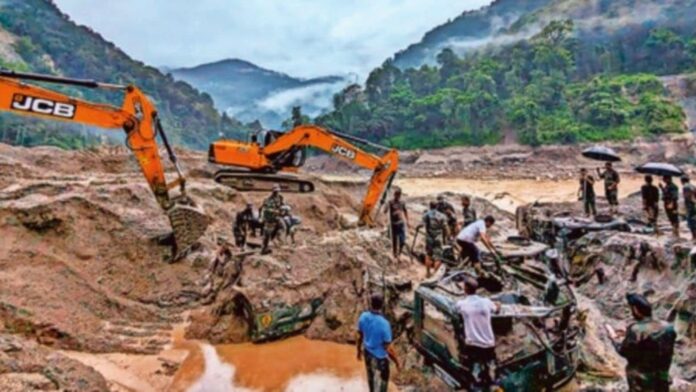Redesigned sikkim dam, the Union environment ministry’s expert appraisal committee (EAC) has raised significant concerns about the proposed redesign of the Teesta-III Chungthang Dam in Sikkim, which was washed away during a catastrophic glacial lake outburst flood (GLOF) in October 2023. The committee deferred its decision to grant approval, emphasizing the need to ensure the dam’s stability and resilience against future disasters in the region.
Sikkim Urja Limited, a government-owned enterprise, has proposed redesigning the dam with a concrete gravity structure and increasing its spillway capacity from 7,000 cumecs to 19,946 cumecs to better handle extreme hydrological events. However, the EAC remained unconvinced, highlighting the need for further reviews, expert opinions, and a site visit before moving forward with the project.
Concerns Over The Redesigned Sikkim Dam
The expert panel expressed reservations about the structural design and safety of the proposed concrete gravity dam. Given the region’s vulnerability to extreme hydrological events, including glacial lake outbursts, the committee stressed the importance of designing a dam that can withstand such challenges.
The Teesta-III Chungthang Dam, located in Mangan district, was originally a concrete-faced rockfill dam. The GLOF event in October 2023, triggered by an ice avalanche that breached the South Lhonak Lake, overwhelmed the dam, causing significant destruction downstream. Forty lives were lost, and 100 villages across Mangan, Gangtok, Pakyong, and Namchi districts were severely impacted.
The redesigned dam proposes advanced safety features, but the EAC has sought inputs from the Central Electricity Authority (CEA) and other experts to evaluate the viability of the modifications. The committee has also formed a sub-committee to visit the site for a detailed assessment.

Details Of The October 2023 Disaster
On the night of October 3 and October 4, a massive ice avalanche hit the South Lhonak Lake, situated at an altitude of 5,200 meters. The avalanche breached the lake, leading to a powerful GLOF that caused flash floods downstream.
The floodwaters breached the Chungthang Dam, further exacerbating the devastation. The disaster resulted in the loss of 40 lives, left 76 people missing, and affected over 100 villages across four districts. The underground powerhouse of the Teesta-III project was flooded, halting power generation.
The catastrophe highlighted the risks posed by glacial lakes in the region, spurring both the Centre and the Sikkim government to launch initiatives to mitigate future disasters.
Proposed Restoration Plans For The Dam
Sikkim Urja Limited has presented a comprehensive plan to restore the Teesta-III project. The company proposes:
- Partial Power Generation: Constructing a coffer dam upstream to enable partial power generation within a year.
- Main Dam Restoration: Rebuilding the main dam within three years at an estimated cost of ₹4,189.51 crore.
- Enhanced Safety Features: Incorporating a concrete gravity structure and increasing spillway capacity to handle potential GLOF events and maximum flood scenarios.
Despite these proposals, the EAC deferred its nod, citing the need for a thorough evaluation of the dam’s design and safety measures.

Government’s GLOF Risk Mitigation Programme
The October disaster has led to increased efforts to mitigate the risks posed by glacial lakes in Sikkim. The Centre has approved a ₹150 crore National GLOF Risk Mitigation Programme, under which 189 high-risk glacial lakes have been identified for assessment and intervention.
The Sikkim government has launched high-altitude expeditions to evaluate the susceptibility of lakes such as Khangchung Chho, Gurudongmar Lakes A, B, and C, and Shako Lakes. The Khangchung Chho Lake, located at 5,320 meters, is particularly concerning due to its large surface area of 183 hectares and an estimated volume of 106 million cubic meters.
Teesta-III Project’s Strategic Importance
The Teesta-III hydroelectric project, located between Chungthang and Sankalang villages, utilizes an 800-meter drop in the Teesta River to generate 1,200 MW of power. It is one of Sikkim’s most critical infrastructure projects, contributing significantly to the state’s energy supply.
The project’s destruction has had severe economic and social repercussions, underscoring the need for robust infrastructure that can withstand natural disasters. However, restoring the dam presents a complex challenge, requiring careful consideration of environmental, technical, and social factors.
Environmental Concerns And Challenges
Environmentalists have raised concerns about the ecological impact of the Teesta-III project and its restoration. The proposed redesign must address:
- Sustainability: Ensuring the project aligns with the fragile ecosystem of the Himalayan region.
- Resilience: Incorporating features that can withstand extreme weather events exacerbated by climate change.
- Community Impact: Minimizing disruptions to local communities and ensuring their safety in future disasters.
The region’s dependence on hydropower underscores the importance of balancing energy needs with environmental sustainability.
Next Steps For The Redesigned Sikkim Dam
The EAC’s decision to defer approval highlights the need for a cautious and thorough approach to the dam’s restoration. The site visit by the sub-committee, along with expert inputs from the CEA and other agencies, will play a crucial role in determining the project’s future.
The lessons learned from the October 2023 disaster emphasize the importance of integrating climate resilience into infrastructure planning. For the Teesta-III project, this means ensuring that the redesigned dam not only meets current safety standards but also anticipates future risks.
The collaboration between the Centre, the Sikkim government, and various expert agencies offers hope for a balanced solution that addresses both energy demands and environmental concerns. However, the path forward will require careful coordination, transparent decision-making, and a commitment to prioritizing safety and sustainability.
As Sikkim rebuilds in the aftermath of the GLOF disaster, the Teesta-III project stands as a symbol of both the challenges and opportunities in navigating the intersection of development and environmental responsibility.

